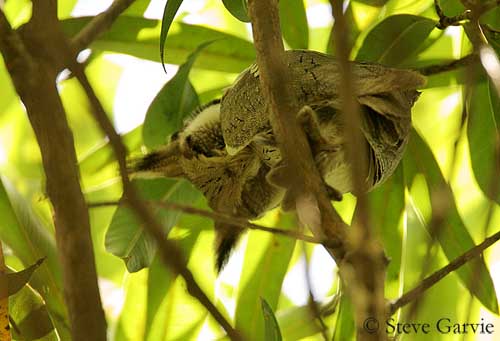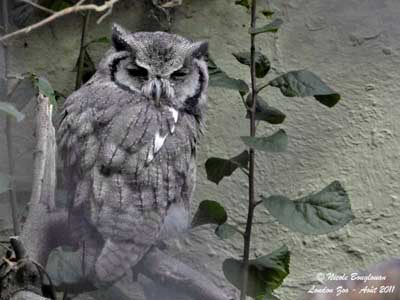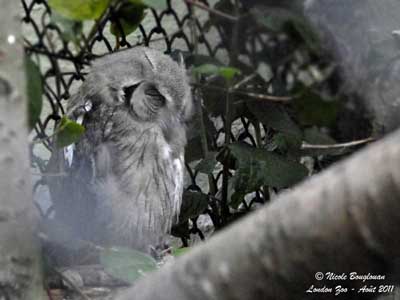
Northern White-faced Owl
Ptilopsis leucotis
Strigiforme Order – Strgidae Family
BIOMETRICS:
Length : 24 à 28 cm
Weight : 185 à 220 g
DESCRIPTION:
Northern White-faced Owl is a short-tailed Owl with prominent ear-tufts. Its plumage is soft grey with darker streaks and vermiculations. We can see a line of white spots down each side of the back. It has darker upperparts than whitish underparts.
It has a conspicuous white facial disk bordered with black. Bill is pale grey, darker at the base. Large eyes are red to orange. Feathered legs and feet are pale grey with black claws.
Both sexes are similar.
Juvenile is brownish, with greyish-brown facial disk.
Ptilopsis leucotis has two subspecies: Ptilopsis leucotis leucotis and Ptilopsis leucotis margarethae.
DIET:
Northern White-faced Owl feeds on insects, small birds, rodents and small mammals.
PROTECTION / THREATS / STATUS:
Northern White-faced Owl is widespread throughout Senegal in suitable habitat. It is locally common breeding resident and abundance varies locally.
Fr: Petit-duc à face blanche
All : Büscheleule
Esp : Autillo de Cara Blanca
Ital : Assiolo facciabianca
Nd: Witwangdwergooruil
Photographers:
Jean Michel Peers
His website:
JMPN PHOTOGRAPHIE
Steve Garvie
His website :
RAINBIRDER Photo galleries
Nicole Bouglouan
PHOTOGRAPHIC RAMBLE
Text by Nicole Bouglouan
Sources:
HANDBOOK OF THE BIRDS OF THE WORLD Vol 5 by Josep del Hoyo-Andrew Elliott-Jordi Sargatal - Lynx Edicions - ISBN: 8487334253
BIRDS OF AFRICA SOUTH OF THE SAHARA by Ian Sinclair and Peter Ryan - Princeton University Press Princeton and Oxford - ISBN: 0691118159
Owls and Owling in Southern Africa by Warwick Tarboton and Rudy Erasmus - Tracey Hawthorne - ISBN: 1868721043

VOICE: SOUNDS BY XENO-CANTO
Northern White-faced Owl’s common call is a quiet “po-proo” with accentuated second note.
HABITAT:
Northern White-faced Owl lives in savannahs, open and riverine woodlands and thornveld with acacias.
RANGE:
They live in Africa, from Sahara edges to South West Africa.
BEHAVIOUR: Northern White-faced Owls are strictly nocturnal spending the day in their cavity, and hunting at night among scrubs and bushes, woodlands and savannahs.
They are often seen in pairs at their usual roost. They may also roost with other owls. They are also found in towns where they spend the day sleeping in holes in buildings.
When disturbed, it adopts an erect posture, looking emaciated.
To hunt, they perch on wires or cables to search for food. They have very sensitive hearing and sight, and they are able to hear and see rodents running on the ground at night. They may prey upon larger prey than other owls.
FLIGHT:
Northern White-faced Owl has a silent flight diving on its prey from a perch.

REPRODUCTION:
Northern White-faced Owl nests in abandoned nests of other species, often in a cavity in tree, but even on the ground. They nest from May to November.
Female lays 2 to 4 shiny white eggs. Incubation lasts about 30 days, shared by both parents. Chicks are fed and protected by both adults. Young move around the near branches at about 4 weeks, and begin to fly some days later.

